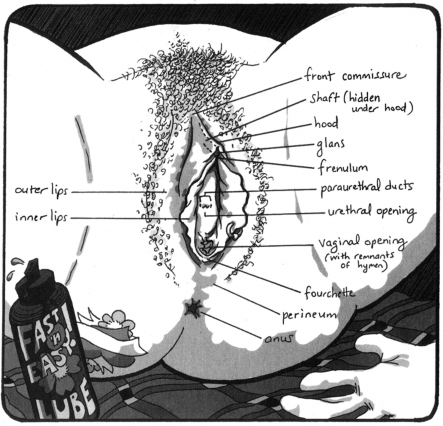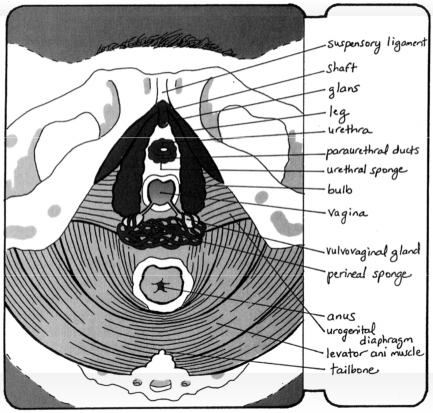Read The Clitoral Truth: The Secret World at Your Fingertips Online
Authors: Rebecca Chalker
The Clitoral Truth: The Secret World at Your Fingertips (4 page)

THE VISIBLE PARTS OF THE CLITORIS
The hairy outer lips (labia majora) are not considered a part of the clitoris because, embryologically speaking, they arise from the same fetal tissue as the scrotal sac, the pouch containing the testicles, which are a major component to the male reproductive system. The visible parts where the clitoris begins are found at the point—the junction or front commissure—where the edges of the outer lips
meet at the base of the pubic mound. (The points where the corners of the eyelids and of the lips meet are also called commissures.)
The word “glans” comes from the ancient Greek word for “acorn,” and was probably chosen because the tip of the uncircumcised penis with its foreskin pulled back looks somewhat like a ripe acorn peeking out of its cap. The clitoris has a glans as well: the exquisitely sensitive nub that is, without question, the crown jewel of the clitoral system. The female glans, however, has one surprising and exhilarating difference. It holds between 6,000 and 8,000 sensory nerve endings, more than any other structure in the human body male or female—and by one estimate about four times as many as the glans of the penis. This hypersensitive little node has only one purpose: pleasure, and its ability to receive and transmit sensations of touch, pressure, and vibration is unsurpassed.
The glans may be the crown jewel of the clitoral system, but the hairless inner lips (or labia minora, Latin for “little lips”) are typically the most prominent feature of the visible clitoris. The moist wings of tissue enfold the glans, the urethral opening, the vaginal opening, and the two ducts of the paraurethral glands on either side of the urethral opening. The appearance of the inner lips varies greatly from woman to woman. They may range in color from pale peach to mauve, burgundy, or dark chocolate and the color may deepen after childbirth. The lips may be very trim and narrow, curled inward, fluted, or so widely flared that they protrude past the pubic
hair, Their texture may be smooth, glassy, almost translucent, or deeply crinkled. It is not uncommon for one lip to look quite dissimilar to its mate. Betty Dodson, who was an artist before she became a sex educator, likes to characterize the inner lips in artistic terms such as “classic,” “gothic,” “baroque,” “art deco,” and “modern.” “They are like snow-flakes,” she says. “Every one is unique and beautiful.”
8
One of the important corrections that the FFWHCs made to the traditional definition of the clitoris was to change the names of the labia majora (big lips) and labia minora (little lips) to outer lips and inner lips. “In looking at our own genitals, and at hundreds of photographs that we took, we observed that `big’ and ‘little’ could be misleading,” explains Carol Downer. “Quite often the ‘little’ lips (labia minora) might be very pronounced, while the ‘large’ lips (labia majora) might be relatively slim... This more accurately describes what you actually see.” It’s interesting that in her intuitive description of the external genitalia, Anne Frank uses the terms “outer labia” and “inner labia” instead of “big” and “little.”
The outer edge of each inner lip flares and continues toward the pubic mound (mons veneris in Latin, or Mound of Venus), forming a protective hood over the glans. The hood is analogous to the foreskin of the penis. The inner edges of the inner lips meet just underneath the glans, forming an upside-down “V.” This point is called the bridle, or frenulum. The inner lips are richly endowed with nerve
endings, making them quite sensitive to sexual stimulation. Some women say that their inner lips are actually more sensitive than the glans.
The bottom edges of the inner lips meet just beneath the vaginal opening, forming an opaque membrane—the little for, or fourchette, which represents the lower boundary of the visible portion of the clitoris. The fork may be torn or cut during childbirth, and its appearance may change or it may be obliterated altogether. Like the commissure that marks the upper extent of the visible clitoris, the fork marks the lower boundary.
If you separate the inner lips and stretch the vaginal opening slightly, you may be able to see the remnants of the hymen. At birth the hymen is stretched across the vaginal opening, but it is often frayed, torn, perforated, or it simply disintegrates by the time a woman reaches her mid-teens. For much of history, the intact hymen has been emblematic of a woman’s virginity, indicated that she has not been penetrated by a man’s penis. This concept was established in early patriarchal cultures when women and children were considered property, and girls were sold into marriage in their early teens. A girl had to be a virgin and remain faithful during marriage in order for her husband to be assured that her children where also his children. Today, the essential fragility of the hymen would seem to make it an unreliable indicator of whether or not a woman has had intercourse. In rare cases, it is possible that a hymen may be elastic enough to admit a penis without tearing.

FIGURE 2: THE VISIBLE PARTS OF THE CLITORIS
Figure 2 shows the visible parts of the clitoris as well as some non-clitoral structures: the outer lips, the urethral opening, where the urine comes out, the vaginal opening, and the perineum, the little bridge of skin between the vagina and the anus. If you have a mirror handy, you can easily locate these structures. While masturbating or having sex with a partner, you can observe how these parts change in size and/or color when you are excited.
The FFWHCs emphasizes the tremendous variation in the size and appearance of women’s genitals. “Working in our clinics we observed a much wider range of ‘normal’ than was ever indicated in medical texts or even sex advice books;’ Downer said. “The implication was that if your genitals didn’t look pretty much like those pictured, you were somehow abnormal. Our experience in the clinic suggested that this was wrong, and decided to set the record straight.”
9
A group from the clinics, together with photographer Sylvia Morales, traveled around the country, taking more than a thousand photographs of women’s genitals. “The enormous variation we observed in the appearance of the visible parts of the clitoris as well as the vulva, vagina, and cervix, convinced us that we were correct,” Downer says. Eventually, a selection of these photographs appeared in
A New View of a Woman’s Body
. Other photographs revealing the variety in the appearance in women’s genitals can be found in
Femalia
, edited by Joani Blank. Drawings can also be
found in Tee Corrine’s classic
Cunt Coloring Book
and in Betty Dodson’s
Sex for One
(see Resources).

In the proverbial locker room, men are known to compare their penises, and this behavior allows them a window into the range of what ‘normal’ actually is. This isn’t something that many women feel comfortable indulging in, and consequently they suffer intense isolation, wondering if they are ‘normal,’ or in some cases, if they even have a clitoris.
Now that we’ve explored the visible parts of the clitoris—you’ve studied the illustrations—you might want to take out a mirror and locate them for yourself. Keep in mind that these illustrations represent only a few of many possible variations in the size and appearance of the clitoris.

THE HIDDEN PARTS OF THE CLITORIS
If you were to remove the top layer of skin and visible structures of the clitoris, it would reveal numerous hidden structures, which Mary Jane Sherfey referred to as the “powerhouse of orgasm.” These structures include erectile tissue, glands, muscles, blood vessels, and nerves. In both the clitoris and the penis, there are two types of
erectile tissue: body of caverns (corpus cavernosum) and spongy body (corpus spongiosum), which fill with blood during sexual response, causing an erection.
The clitoral shaft is attached to the glans, just underneath the sur face of the skin. The shaft is a round fibrous segment of spongy erectile tissue, and like the glans, it is very sensitive. If you roll your finger back and forth just above the glans during sexual response, you should be able to feel a hard ridge about one-half to one inch long, and about the diameter of a soda straw, and rises toward the pubic mound for a short distance, then bends sharply and divides, forming two slender legs or crura (Latin for “legs”), which are also composed of spongy tissue. The legs of the clitoris flare out somewhat like the wish bone of a chicken.
If you look at Figures 3 and 4, you will notice that underneath the inner lips are twin bulbs of cavernous erectile tissue. During sexual response these structures fill with blood, which then becomes trapped in their cryptic spaces, causing erection.
In both women and men, the urethra (the tube through which we urinate), is surrounded by a ring of spongy erectile tissue that is identical to the type of erectile tissue, corpus spongiosum, that surrounds the penis. In women, the urethra is about two inches long, and runs from the bladder to the urethral opening just above the opening to the vagina. “In nearly all of the modern anatomy books that we looked at, the erectile tissue surrounding the urethra was


FIGURE 3: THE HIDDEN PARTS OF THE CLITORIS (FULL ON VIEW) FIGURE 4: THE HIDDEN PARTS OF THE CLITORIS (3/4 VIEW)
